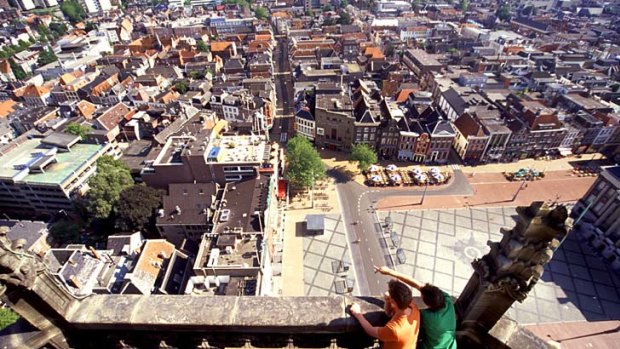
Hardly nether ... view from the Martinitoren.Credit: Alamy
Sue Joseph tackles pronunciation and poffertjes head on in the land of the 'sea people'.
For more than a year now I have been practising the name of the northern Dutch city of Groningen (pronounced Crone-ing-en). It is where my partner was born, his parents and his grandparents before them.
With all best intention, I argued to the Dutchman, I had to be able to pronounce the name of the city of his birth, despite its guttural "gr", if we were going there together. It was the least I could do. But for more than a year, I failed.
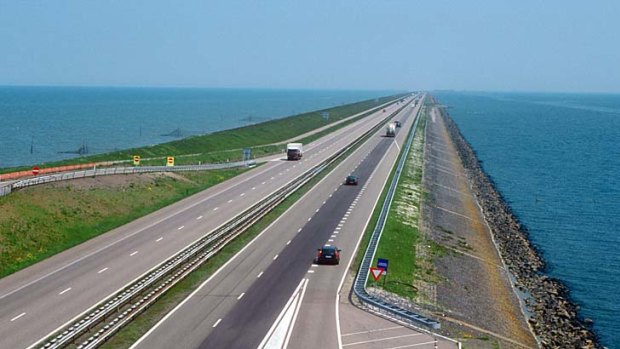
The Afsluitdijk.Credit: Alamy
Desperate pleas for the Dutchman to say this word, followed by feeble attempts to get my tongue and palate around its heavy West Germanic inflection, met with tolerant smiles and slight nods but little success.
And now, we are on our way to Groningen and 103 kilometres south of it, travelling across the Afsluitdijk (pronounced Af-sly-dike). Surprisingly, my pronunciation of this most bizarre Dutch word is much closer to the mark. Or so I comment to the Dutchman. I'm not quite sure he agrees, however.
It seems to me that the Dutch have been excessively involving themselves with water for centuries. They sailed across it in exploration and empire building, for trade and to wage wars. They sucked the land dry of it, creating polders where they settle and farm and build cities. They built dykes and sluice-like locks, to manage and control waterways, to keep the water out or to keep it in.
About 200 little indents - and delicious scents.
From time to time they even glide through it more speedily than our world-renowned swimming champions, to beat us at one of our best games.
And now this place - the Afsluitdijk. Thirty-two kilometres of a four-lane A7 Snelweg (freeway) nestling beside a huge, grass-covered dyke - a colossal mound of till, sand and clay.
I wonder aloud about the monumental engineering feat. The Dutchman looks at me as if it is the most ordinary thing in the world. This is what the Dutch do, he says. "We build dykes."
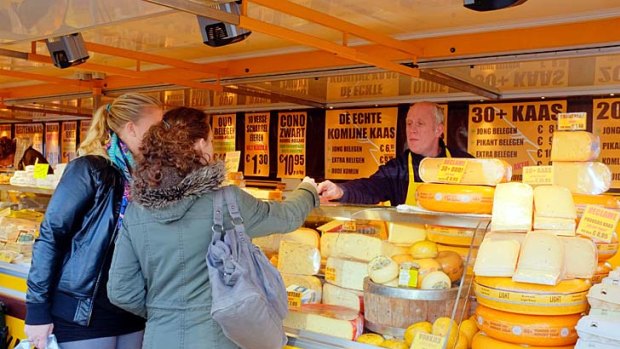
Cheese stalls in a Groningen market.Credit: Alamy
At some point in the early 1900s it was decided to split the sea at this spot - literally - in a bid to join the far northern province of Friesland to North Holland province, and to protect or have some control over rising stormwaters. Some 30 years later, this man-made barrier, designed by politician and civil engineer Cornelis Lely, divided the Zuiderzee in two, creating the Wadden Sea, a saltwater tributary of the North Sea, on one side and the IJsselmeer - the freshwater result of the dyke - fed by the IJssel River, on the other.
At 1.02pm on May 28, 1932, the Zuiderzee ceased to exist as the dyke was joined. After five years, 23 million cubic metres of sand and 13.5 million cubic metres of till, taken from the sea bottom, the Afsluitdijk was joined. At more than seven metres above sea level and 90 metres wide, it took one more year to build the roads and overall provided work for 4000 to 5000 people a day throughout the Great Depression.
There is a monument, fittingly called The Monument, about a third of the way across this dyke from the southern end, or province of North Holland. We stop and drink coffee at its base, looking out at the immensity of fresh water on this side. Far away on the horizon are dots of boats that look like old-time clippers - these, the Dutchman tells me, are ketches, ordinary boats in the Netherlands.
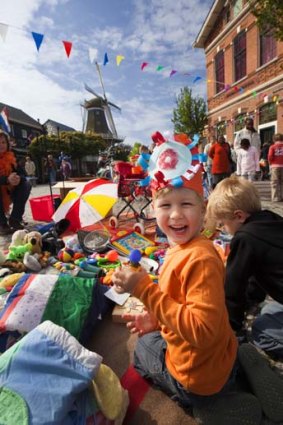
Festival fun in Groningen.Credit: Roelof Bos
I argue that they look like ancient seafaring vessels. He just smiles and shakes his head at me.
The side of the dyke is littered with traditional fishing nets called visnetten and the Dutchman tells me that in winter, the water freezes and when chunks of ice break off, they slam against the basalt piles at the foot of the dyke and freeze in place.
This time I look at him, sitting here in the sunshine, and shake my head. There is a constant humming of vehicles at our back.
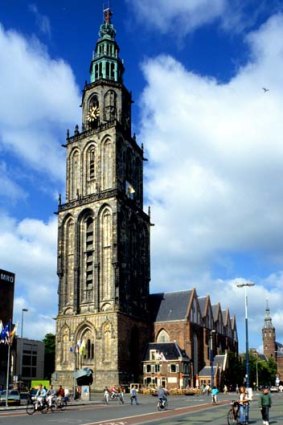
The Martinitoren.Credit: Alamy
We are continuing across the Afsluitdijk again, and the Dutchman tells me he and his family crossed this way hundreds of times on their way to visit his oma (grandma) in Groningen.
We drive through this lush Friesland countryside and wonder out loud at the windmills and wind farms, striking in their high-tech simplicity. Line upon line of three-armed windmill poles flail across the Dutch lands, drawing on the ever-present North Sea winds and powering the nation. We drive under aqueducts and I see the tops of boat masts floating across the roadway. I look at the Dutchman and laugh out loud at the extraordinariness.
When we arrive in Groningen, I see a spire like no other I have seen in this damp land of reaching church spires.
It is the Martinitoren, the Dutchman says. This is his favourite tower in the world, he tells me.
This is his birthplace - the city of his family origin - and not on the regular tourist map. Nothing is in English and I hear no English spoken in the streets. Somehow, I find this deeply refreshing and feel a long way from home, immersed in this vicarious Dutchness.
Groningen is the largest city in the north of Holland. Known as the Metropolis of the North, it has an energy and ambience. It is a small, ancient town, mixing cosmopolitan vitality with a deep and rich history: modern, well-lit and laid-out retail with mediaeval churches and ornate architecture.
The Martinitoren was the tallest building in Europe when it was constructed at the end of the 15th century. It is a mixture of Gothic-ness, Dutch-ness, mediaeval-ness and, somehow, Middle Eastern-ness, all in one. I simply cannot take my eyes off it and everywhere we go throughout the city, it seems to have its scope on me, popping up above buildings from all angles, between the ancient and the new, ever watching.
We glance into the bar where the Dutchman's parents courted nearly 60 years ago, below the 200-year-old Hotel de Doelen, on the Grote Markt, where we are staying. The Great Market was completely destroyed during the final days of World War II, but the Martinitoren remained miraculously untouched.
The Dutchman's mother, Anneke, who was at school on that day, remembers the bullets whistling past. She also recalls Jewish girlfriends disappearing overnight.
This is a university city, with the second-oldest university in the Netherlands, after Leiden University. Founded in 1614, Groningen University is home to some 50,000 students from a wide variety of nations. It educated the first female university student in the country - Aletta Jacobs, a feminist who went on to become the first Dutch female physician. A statue of her is outside the building.
One of the most surreal parts of our visit is the best - the kermis. Three street fairs are held throughout the centre of Groningen every year, each lasting several weeks. We arrive four days before the end of the May kermis. The noise of the carnival and the excitement of the rides continue well into the night. Juxtaposed against the ancient Martinitoren is a huge carousel. Against this mediaeval backdrop is a haunted house and a roller coaster and one of those horrific rides where two cabins dangle at the end of a long, rotating arm - swinging and hanging perpendicular to the ground.
The bitter North Sea winds make me shiver, even in the middle of spring. We walk fast to keep warm and arrive near midnight at the Oud Hollandse Poffertjeskraam, a portable restaurant, full of dim chandelier light, timber floors, a huge old iron grill covered with about 200 little half-circular indents - and delicious cooking scents.
The Dutchman tells me I cannot come to kermis without eating poffertjes - tiny pancakes made from buckwheat and yeast, straight from his childhood memories. The chef is Dirk and I watch as he creates this Dutch delicacy. I help him flip them and then he piles 20 poffertjes onto my plate, covers them with icing sugar and chocolate sauce, piles it with strawberries then cream, then more chocolate sauce and strawberries.
If you don't clean the plate, you have to do the washing up, Dirk warns me.
It is not hard to clean the plate. Extraordinarily delicious.
That's what the Dutch eat, the Dutchman tells me with a smile. This is exactly as he remembers it when he was a child - beautiful poffertjes; beautiful people.
The next night the Dutchman insists on more food from his childhood visits to kermis, but explains that his mother also made these, every New Year's Eve - oliebollen and kranter bollen - again, bathed in icing sugar and so light and delicious I cannot believe I have survived without these already in my life.
This is traditional Dutch, he tells me. As Dutch as you can get.
I ask the Dutchman how he reconciles his life now - born in a mediaeval Dutch city and ending up living by the sea, on the central coast of NSW, in a country less than 230 years old.
It is just so different, I emphasise, looking at him. Everything is different.
This is what the Dutch do, he explains. "We are a sea people and we cross the seas. We live by the sea. This is just normal."
He smiles and nods, pleased with his answer.
And it seems we are back at the beginning, once more discussing the Dutch and the sea.
Trip notes
Getting there
Drive the A7 from Amsterdam, across the Afsluitdijk, to Friesland. Groningen is 183 kilometres from Amsterdam, which takes about two hours by car.
Staying there
The 200-year-old Hotel de Doelen is the perfect spot to base yourself and walk this city. Prices start at slightly more than $100 for a twin room. hotel-dedoelen.nl.
See + do
Stop at The Monument, halfway across the Afsluitdijk (afsluitdijk.org), for coffee and immense views on either side.
In Groningen, the Martinitoren, the Grote Markt, the Town Hall, Groningen University and the Renaissance-style Prinsentuin Gardens are all within easy walking distance of the city centre.
More information
holland.com
Sign up for the Traveller Deals newsletter
Get exclusive travel deals delivered straight to your inbox. Sign up now.